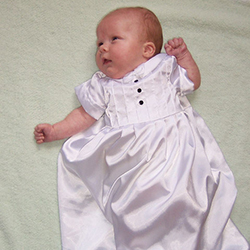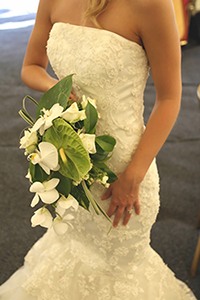Christening Gowns
Cleaning the gown shortly after use will facilitate stain removal. 1. Soak the gown in soap and water for an hour or so. Do this to soften and dissolve any drool or milk from the baby. I recommend “Powdered Tide Plus Bleach”. Do not confuse this with powdered Tide and you add bleach. One type of Tide has a color safe bleach within the product and is marketed as “Tide Plus Bleach”. I am not a big fan of Woolite®. Use warm water. Hand agitate three or four times for gentle cleaning. 2. Thoroughly rinse the gown. Put the gown inside a net bag, put the bag into your washer. Do not add soap. The gown has enough soap from the hour of soaking. Wash on a gentle cycle. To rinse by hand, change the water four times. 3. Avoid using chlorine bleach. Chlorine bleach will degrade silk and may yellow synthetic fibers such as polyester. If you feel compelled to bleach, first try hydrogen peroxide. Flush thoroughly. If chlorine bleach is required: First mix the bleach 4 parts water, 1 part bleach Use a cotton swab to apply a small amount to the stained area. Rinse, Rinse, Rinse, Rinse! 5. Lightly steam press. Place in an acid free box. Sealed plastic boxes do not breathe. I prefer boxes designed to store christening gowns. Keep these instructions with the gown for the next person who uses the gown. This paper is acid free and lignin free. For family fun, make a chronological record on the back of this sheet about the use of the gown. 6. Store the christening gown in a cool, dry place. A good place is in the air conditioned part of the house in a closet or under a bed. Do not store in an attic, it is too hot. Do not store in a basement. A basement is too damp. Be careful of concrete floors and concrete walls that could have moisture and cause mildew....
Read MoreWedding Gown Info
The gown. Have the gown cleaned shortly after the wedding. Impurities on the gown will age with time and become more difficult or impossible to remove. A good time period would be within two weeks, at most a month. Decorative trim is the major concern when cleaning wedding gowns. First, the plastic beads on the gown may dissolve, either partially or totally if the gown is drycleaned. Your dry cleaner can test a sample of the beads before dry cleaning to determine if the beads will dissolve when dry cleaned This test is performed by immersing the beads in dry cleaning solvent for thirty minutes. This test is limited in value for two reasons. First, only some of the beads are tested. Beads of different styles or manufacturer may contain different materials. Secondly, the beads are often coated with a finish that is resistant to dry cleaning solvents, but the thread hole through the center of the bead is not coated. With this type of bead, the dry cleaning solvent will dissolve the plastic on the inside of the bead, leaving only an “eggshell” or thin shell. Secondly, the appliqués on the gown may be attached with glue, rather than being sewn. If the appliqués are attached by glue, the cleaning process may dissolve the glue. The suitability of the glue to cleaning cannot be readily determined. The cleaning process. The cleaning process begins with an inspection of the gown. Stains are treated to ensure proper stain removal. Next the gown is cleaned by either dry cleaning or wet cleaning. Wet cleaning is a cleaning process that uses water, limited agitation, and special soaps. The preferred method to use for cleaning is to wet clean the gown. Most of the stains on a wedding gown (champagne, soft drinks, cake, dirty hem) are water soluble. Wet cleaning will naturally dissolve these type of stains. The plastic beads are not affected by water. The glue used to attach appliqués and beads may be affected, depending on the type of glue. Dry cleaning solvent will naturally dissolve oily type stains, with limited capability to dissolve water soluble stains. When Oak Forest Cleaners dry cleans a wedding gown that will be placed in storage, the gown is first cleaned using a modified dry cleaning cycle. Soap is added as in normal cleaning, but agitation is limited. Next the gown is rinsed in distilled solvent in order to remove any soap that may remain in the gown. After either wet cleaning or dry cleaning, a second inspection is performed, and if additional cleaning is required, it is performed. The gown is then pressed, and packaged for storage. The finished product. When a gown is claimed by the customer, please open the packaging and inspect the gown. We have given extra effort to not contaminate the gown after it has been cleaned. Make sure your hands and the surrounding area are clean. Ensure that all pieces are present. When storing the gown, do not place it in an attic or in a basement. An attic is not desirable because the heat can cause problems. The basement is not desirable because of high humidity which is necessary for insects to survive or dampness which promotes mildew. Pins and foam padding should be removed from the gown. Headpieces, veils, shoes, or other accessories should be stored separate from the gown. Questions and answers. Will my gown yellow? Some yellowing is normal over the years. The hot temperatures in an attic will accelerate any yellowing. Open the box and inspect the gown at least every 5th anniversary....
Read MorePlastic Bags
The plastic bag your cleaner uses to protect your garments in transit between his store and your house, should be removed as soon as you get your clothes safely home. This plastic covering has not been designed for long-term storage. It will not allow air to reach the fibers and it prevents the fabric from ‘breathing.’ If left on for prolonged periods of time this plastic can deteriorate and cause oxidation (yellowing), fume fading and mildew to occur. If you want to protect your garments from dust and airborne mites, use a cotton sheet or a ventilated garment bag. And remember to keep the plastic wrap out of the hands of children. Put them in your recycling bin or bring them back to Oak Forest; we will recycle them for you....
Read More






